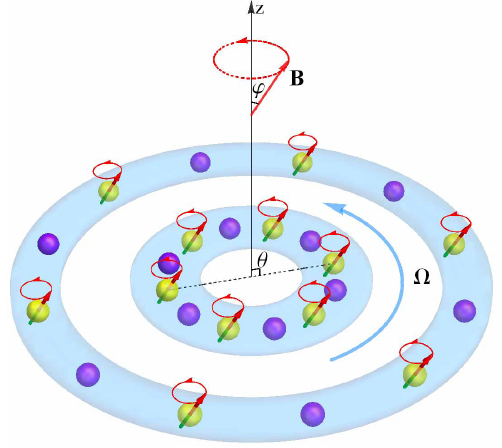Recently, the research group led by researcher Zhang Shougang of Quantum Frequency Standards Lab (Key Laboratory of Time and Frequency Primary Standards of CAS) from NTSC, Chinese Academy of Sciences made new advances on the research of dipolar quantum gases. The article entitled “ Two-component dipolar Bose-Einstein condensate in concentrically coupled annular traps ” has published in 《Scientific Reports》, which is a primary research publication from the publishers of Nature, covering all areas of the natural and clinical sciences.
Team members Zhang Xiaofei, Dong Ruifang, Chang Hong and Zhang Shougang investigate the ground-state and rotational properties of a rotating two-component dipolar Bose-Einstein condensate, which consists of both dipolar bosonic atoms with magnetic dipole moments aligned vertically to the condensate and one without dipole moments, confined in concentrically coupled annular traps (see Fig. 1). The results show that the tunable dipolar interaction can be used to control the location of each component between the inner and outer rings, and to induce the desired ground-state phase. Furthermore, it is found that various ground-state phases and the related vortex structures, such as polygonal vortex clusters and vortex necklaces, can be obtained via a proper choice of the dipolar interaction and rotational frequency (see Fig. 2). The findings not only help to deepen the understanding of the interaction between light and matter, but also can be verified directly by the current ultra-cold atom experiments. It also provides guide to the effective preparation and detection of such exotic quantum phases in real experiments.
This work was supported by National Major Fund of Scientific Equipment and Instrument Development of China, National Natural Science Foundation of China, Hundred-Talent Program of CAS, the key project fund of the CAS for the “Western Light” Talent Cultivation Plan, the Science and Technology Project of Shaanxi Province, and the Talent Cultivation Plan of NTSC.

Fig.1. Two-component dipolar quantum gases (Image by NTSC)

Fig.2. Typical vortex structures of a two-component dipolar BEC
 Print
Print